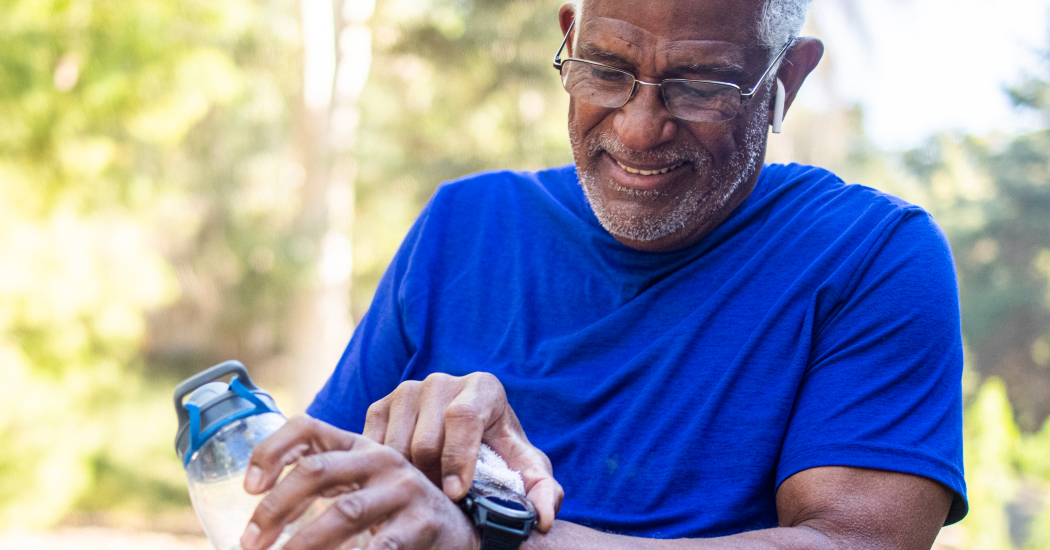Senior Health Care: Are Wearables the Key to Better Health and Happiness?

We’ve been faced with more than our fair share of challenges over the past few years–but meeting and exceeding them can also be beneficial to our mental and physical wellbeing. Wearables, generally thought of as trackers of physical health metrics, can also present users with various emotional challenges that can be tailored to create personal goals that add meaning and purpose to life. Overcoming challenges and meeting age-appropriate goals are just two benefits of wearables that can lead to better overall senior health.
Wearables Emerge as Daily Health Tools
Much has been written lately about how the pandemic has driven the adoption of telemedicine across multiple population segments—even among the allegedly tech-shy senior cohort. Not surprisingly, live video telemedicine adoption increased most among younger age segments, but even seniors’ use of telemedicine (through video, phone, text, email, app or picture messaging) jumped 300% during the beginning of the pandemic, with 43% indicating continued use. While telemedicine adoption among seniors is encouraging, video chats with doctors are not necessarily going to make seniors healthier, or happier.
An emerging trend that is more promising for the health of seniors is the use and integration of digital wearables into their everyday lives. First, let’s define wearables. Generally, wearables are hardware worn on, or in, the body that digitally track and measure health metrics such heart rate, blood pressure, sleep, stress, oxygen levels, temperature, mindfulness, as well as the typical physical activities such as steps, exercise and sports.
Wearables can also potentially benefit senior health and happiness. Fitness and wellness wearables are not only understood to play a role in preventative health care via cardio, weight management and cognitive function; they’re also used to track chronic health conditions such as diabetes, blood pressure and heart disease—particularly among older populations. According to a 2020 study by Stanford Medicine and Rock Health, wearable use was up in 2020, with 43% of respondents, ages 18 and up, reporting they own a wearable, up from 33% in 2019. In 2020, 51% of all wearable owners were using their wearable to manage a diagnosed health condition, up from 28% in 2019.
We often think of digital wearable benefits solely in the context of physical health, mainly cardio and weight management, but the category is now expanding to emphasize the emotional and cognitive wellness benefits. Seniors can be a lucrative target for wearable technology given the time and financial affluence of this key demographic segment who are redefining the historically sedate and inactive image of retirement.
Thriving in Retirement
With Baby Boomers living longer than previous generations and having an abundance of time and affluence in retirement, they are increasingly pursuing stimulating and meaningful activities. Rain the Growth Agency’s Boomer Silver Tsunami Segmentation research indicates that older Americans seek everyday challenges to stay busy and create a sense of purpose and accomplishment in life, especially during retirement. The research indicates that Boomers are significantly more likely than the general population to say that “accomplishing a challenge” brings joy to their lives.
For most adults, the main source of challenges comes from their job and work environment. However, individuals often lose this outlet when they retire. When unable to regularly accomplish challenges, retirees can feel bored or without purpose. Retirees lacking a sense of purpose are more likely to experience some form of depression and express dissatisfaction with their retirement.
Wearables can play a key role not only in helping to improve overall senior health through biometric tracking, but also by providing daily goals retirees can strive for in the number of steps taken per day or maintaining a healthy heart rate. Baby Boomers are thus redefining the historically sedate and inactive image of retirement by pursuing stimulating and meaningful activities. Wearables can capitalize on the propensity towards more physical activity among this segment, and meeting these goals can likely give seniors a greater sense of purpose and satisfaction, which hopefully leads to greater joy and happiness.
However, they first need better education. While senior wearable ownership has increased, more than half, 54%, say they need help understanding how the devices work. Consequently, wearable wellness brands targeting older populations need to include educational programs in their offerings to help upskill senior digital confidence and help drive wearable adoption among seniors seeking an active, purposeful and happier “”Third Act” in life.
The Boomer Silver Tsunami Segmentation breaks down the demographics and lifestyles of three segments – Nostalgic Conservatives, Seniors Living Simply and Progressive Nesters – to help brands understand what motivates this unique population and can help shape how they message the advantages of wearables.
Rain the Growth Agency utilizes extensive consumer insights and proven experience marketing to Baby Boomers to help DTC brands achieve transformation growth. To learn more, visit https://55plus.rainforgrowth.com/.
